This article details the creation of just-intonation scales, focusing specifically on how these scales are derived from the Indian murcchana-s of Ma-grama. It explains the scale model derived from two cycles of perfect fifths, which aligns with Western and Indian musicological concepts of microtonality. The text provides a transposition table for generating various scales and outlines procedures for adjusting and aligning minor and major exported scales to ensure they have accurate just-intonation properties. The aim is to produce musically accurate scales by adhering to specific frequency ratios and theoretical frameworks, drawing on historical and cross-cultural music theories.
The following is the procedure for exporting just-intonation scales from the murcchana-s of Ma-grama stored in "-to.12_scales".
➡ Read Just intonation: a general framework for explanation.
The scale model
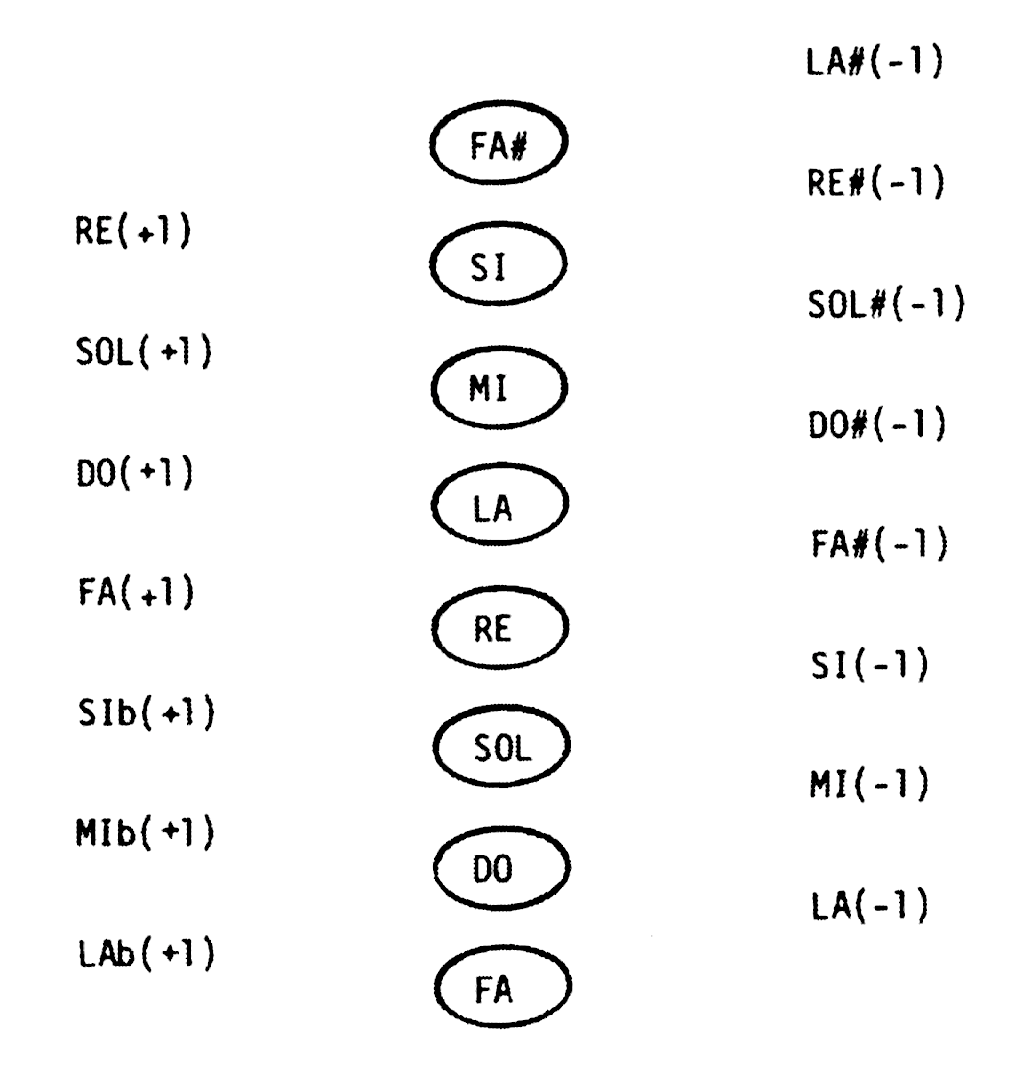
As indicated on the page Just intonation: a general framework, just-intonation chromatic scales can be derived from a basic framework made of two cycles of perfect fifths (frequency ratio 3/2).
These produce the 22-shruti framework of Indian musicologists (read Raga intonation) or the series called "Pythagorean" and "1st-order ascending-third" ("LA-1", "MI-1" etc.) in the approach of western musicologists (see picture on the side).
We have found that the "1st-order descending-third cycle" ("LAb+1", "MIb+1" etc.), in which all notes are higher by a syntonic comma may not be necessary for the creation of just-intonation chords.
These cycles of fifths are represented graphically (scale "2_cycles_of_fifths" in the tonality resource "-to.tryTunings"):
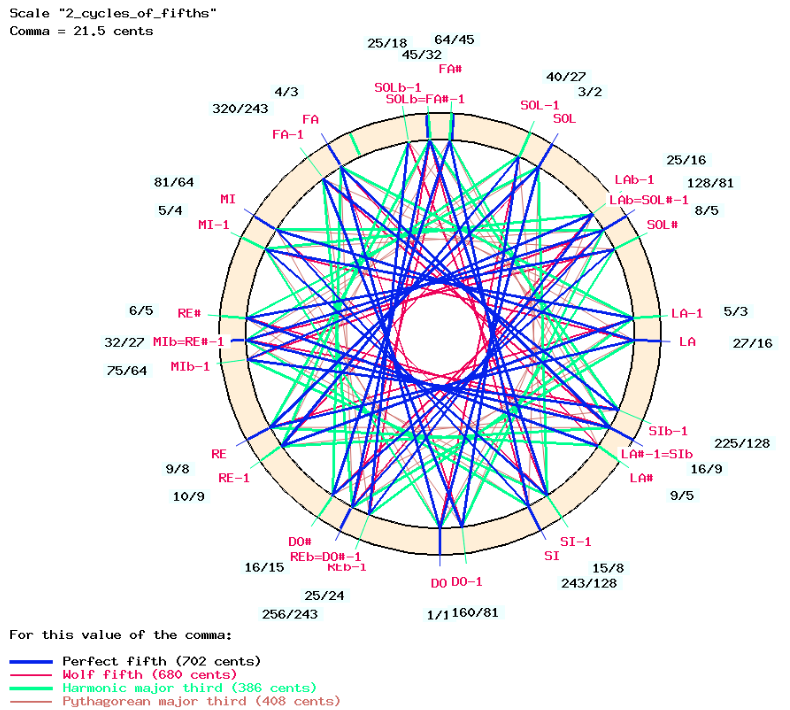
There are some differences between this 29-degree division of the octave and the Indian framework, notably the creation of "DO-1" and "FA-1", two positions one syntonic comma lower than "DO" ("C" = "Sa" in the Indian convention) and "FA" ("F" = "Ma"). Interestingly, these positions appear in ancient texts under the names "cyuta Sa" and "cyuta Ma". Other additional positions are "REb-1", "MIb-1", "SOLb-1", "LAb-1" and "SIb-1".
The rule we follow when creating chromatic scales from transpositions of Ma-grama is that only the positions shown on this graph are considered valid. When exporting a minor or major chromatic scale from a transposition of Ma-grama, it may happen that a note position is not part of this framework. In all cases of this procedure, the invalid position is one syntonic comma too low. Therefore the exported scale is "aligned" by raising all its positions by one comma.
The term "Pythagorean series" is confusing because any cycle of perfect fifths is Pythagorean by definition. Whether a position in a scale "is" or "is not" Pythagorean depends on the starting note of the series that was announced as "Pythagorean". In Asselin's work the starting point of the series in the middle column is "FA". In the Indian system, the basic frameworks (Ma-grama and Sa-grama) start from "Sa" ("C" or "do") and the Pythagorean/harmonic status of a position is determined by factors of its frequency ratio with respect to "Sa". If a factor "5" is found in the numerator or the denominator, the position is harmonic or, conversely, Pythagorean.
For example, "DO#" in Asselin's "Pythagorean" series (two perfect fifths above "SI") is evaluated as a harmonic position (marked in green) on the Bol Processor graph and its ratio is 16/15. In reality, "DO#" in Asselin's series has a frequency ratio of 243/128 * 9/16 = 2187/1024 = 1.068 which is very close to 16/15 = 1.067. "DO#-1" in Asselin's series is two perfect fifths above "SI-1" which gives a frequency ratio of 15/8 * 9/16 = 135/128 = 1.054 which is close to 256/243 = 1.053 and marked "Pythagorean" on the Indian scheme. Thus, "DO#" and "DO#-1" have exchanged their properties, each being the superposition of two very close positions belonging to different series.
Ignoring schisma differences inn order to take the simplest ratios creates this confusion. For this reason, we still prefer to use comma indications — e.g. "FA" and "FA-1" — to identify positions where the first instance belongs to the series called "Pythagorean" in Asselin's work.
Transposition table

This table summarises a quick procedure for creating all the murcchana-s of the Ma-grama chromatic scale and exporting minor and major chromatic scales from them.
Open the scale "Ma_grama" in the "-to.12_scales" tonality resource, and select the Murcchana procedure. To create "Ma01", move note "F" to note "C" and click on TRANSPOSITION.
| F moved to | Murcchana | Minor scale | Raise | Major scale | Identical scale | Adjust | |
| C | Ma01 | Amin | D | Cmaj | = | Emin | 1/1 |
| F | Ma02 | Dmin | G | Fmaj | = | Amin | 1/1 |
| Bb | Ma03 | Gmin | C | Bbmaj | = | Dmin | 1/1 |
| Eb | Ma04 | Cmin | F | Ebmaj | = | Gmin | 1/1 |
| Ab | Ma05 | Fmin | Bb | Abmaj | = | Cmin | 1/1 |
| Db | Ma06 | Bbmin | Eb | Dbmaj | = | Fmin | 1/1 |
| F# | Ma07 | Ebmin | Ab | F#maj | = | Bbmin | 1/1 |
| B | Ma08 | Abmin | Db | Bmaj | = | Ebmin | 1/1 |
| E | Ma09 | Dbmin | F# | Emaj | = | Abmin | 1/1 |
| A | Ma10 | F#min | B | Amaj | = | Dbmin | 81/80 |
| R3 | Ma11 | Bmin | E | Dmaj | = | F#min | 81/80 |
| G3 | Ma12 | Emin | A | Gmaj | = | Bmin | 81/80 |
For example, this is the "Ma04" murcchana obtained by placing "F" (M1 on the Indian scale model) of the moving wheel on "Eb" (G1 of the outer crown):
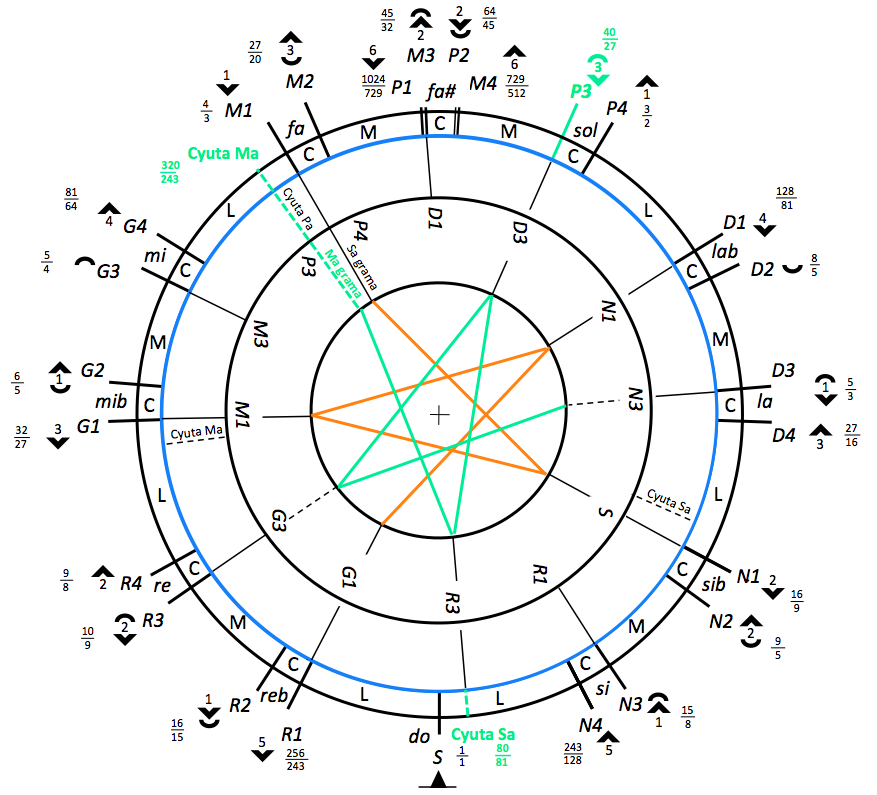
The resulting "Ma04" scale is:
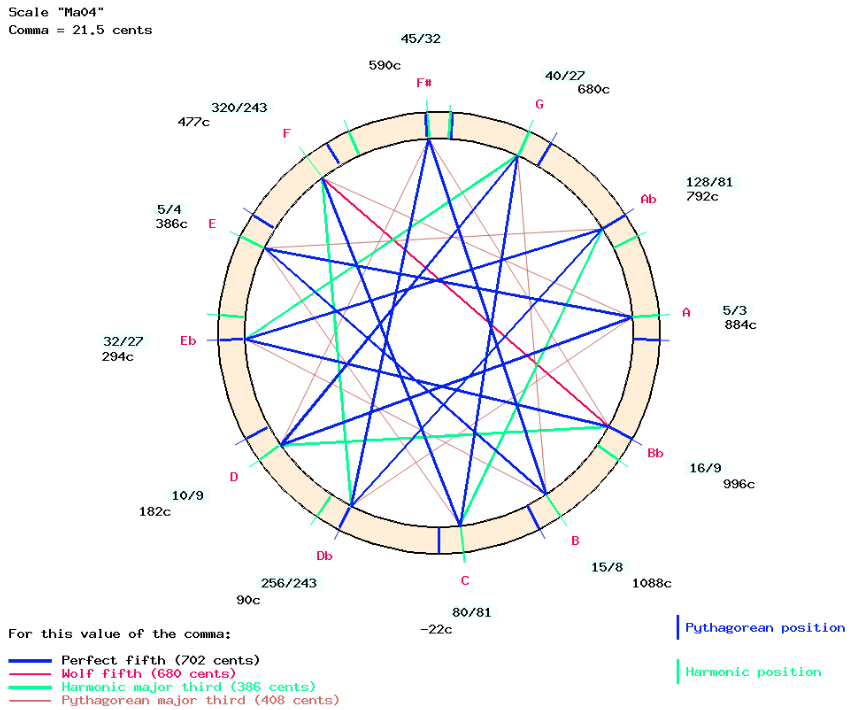
Scale adjustment
In the last column of the table, "Adjust" indicates the fraction by which the note ratios may need to be multiplied so that no position is created outside the Pythagorean and harmonic cycles of fifths according to the Indian system. Practically this is the case when the frequency ratio contains a multiple of 25 in either its numerator or denominator, as this indicates that the position has been constructed by at least two successive major thirds (up or down).

A warning is displayed if this is the case, and a single click on ADJUST SCALE fixes the positions:
In this example, the warning signals an out-of-range position of "B" (50/27) on the "Ma10" scale. Note also that "F#" has a multiple of 25 in its numerator.
After clicking on ADJUST SCALE, the scale "Ma10" is completed with "B" in position 15/8. This has been done by raising all the notes by one syntonic comma (81/80) :
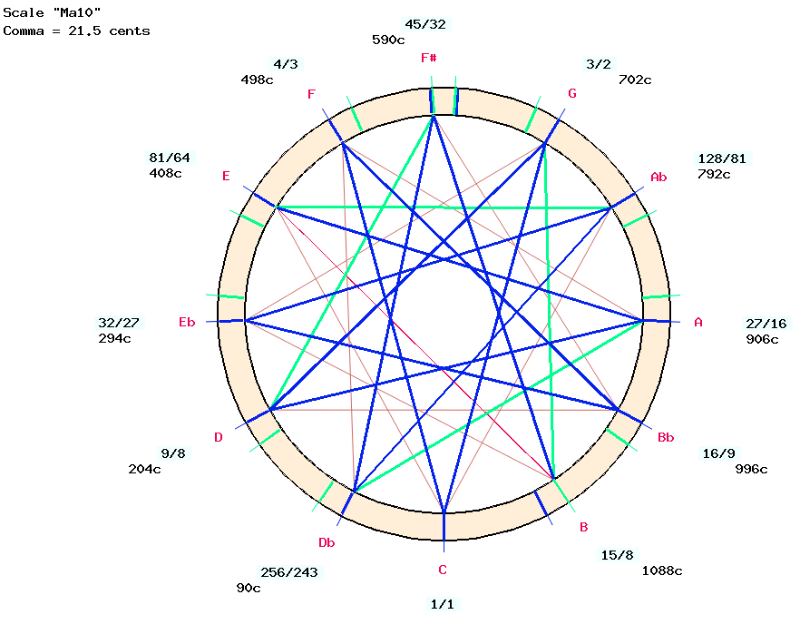
This procedure is known in Indian musicology as sadja-sadharana, which means that all the notes of the scale are raised by a shruti — here, a syntonic comma (Shringy & Sharma 1978). In this model, it is also invoked for the scales "Ma11" and "Ma12". The result is (as expected) a circular model because "Ma13" is identical to "Ma01" as shown by the scale comparator at the bottom of page "-to.12_scales".
This circularity is a property of the set of murcchana-s which has no effect on exported minor and major scales, since their positions are aligned according to the basic rule explained in the first section.
Exporting and aligning minor scales
The "Ma04" murcchana produces "Cmin" by exporting notes facing the marks on the inner wheel.
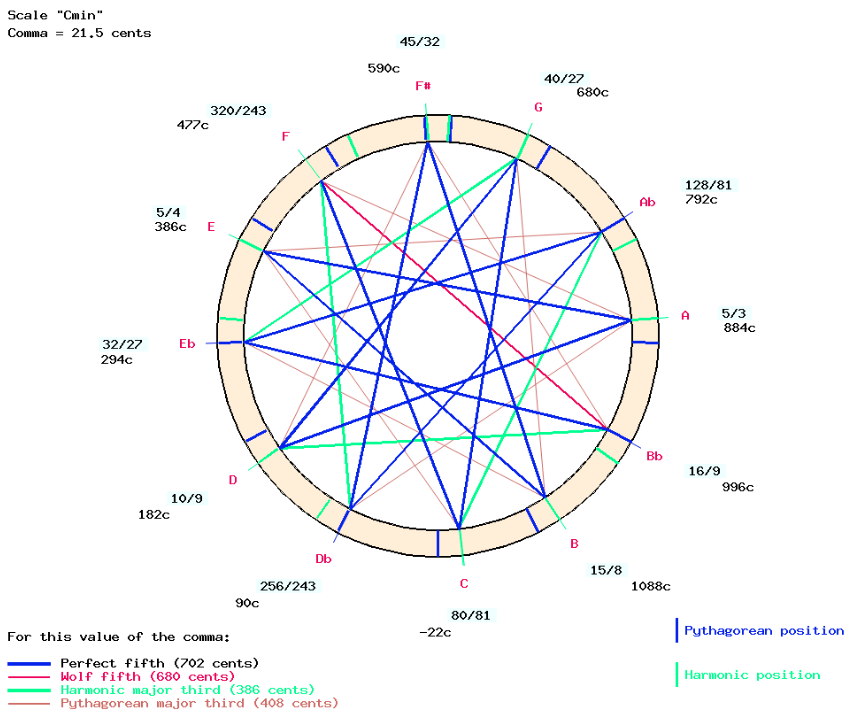
As explained on page Just intonation: a general framework, the tonic and dominant notes of each minor chord should belong to the "minus-1" position. In this example, "C" and "G" are one comma lower in a "C minor" chord than in a "C major" chord (corresponding to "DO-1" and "SOL-1" on the "2_cycles_of_fifths" scale), a fact predicted and experimentally verified by Pierre-Yves Asselin (2000 p. 137).
All chromatic minor scales exported from the murchana-s of the Ma-grama are correctly positioned with respect to the enharmonic positions of the main notes in just-intonation chords. This can be easily checked by comparing the ratios with those associated with the western series on "2_cycles_of_fifths" (top of this page). This confirms that a tuning system using only two series of perfect fifths is suitable for the construction of a just-intonation framework.
Exporting and aligning major scales
The "Ma04" murcchana produces "Ebmaj" by exporting notes facing the marks on the inner wheel and raising "F":
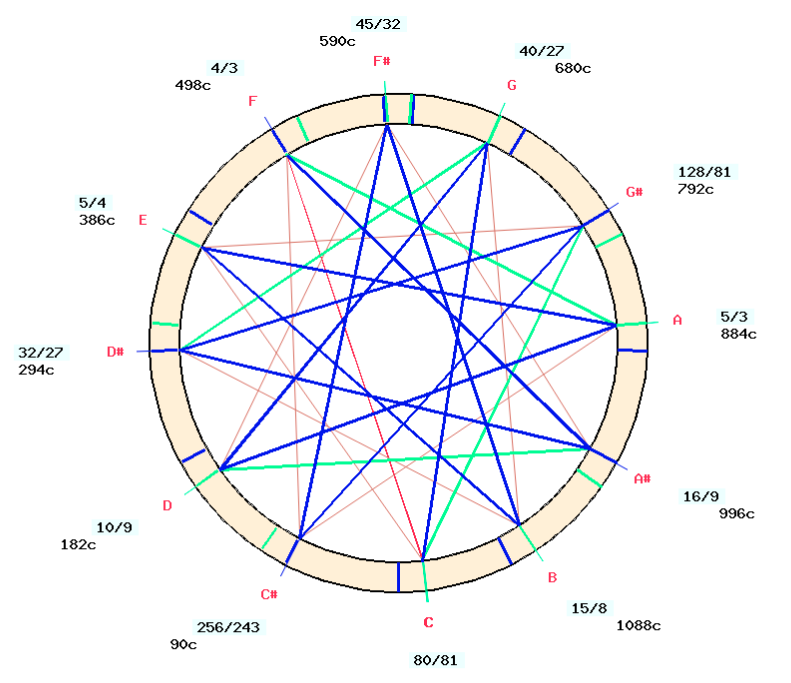
According to a rule explained on the page Just intonation: a general framework, the root of each major chord should be both in the high position and in the Pythagorean series (blue markings). This is true for the chord "Eb major" taken from the chromatic scale "Ebmaj", but not for the scales "F#maj", "Bmaj" and "Emaj" shown in bold on the table.
For example, let us look at "Emaj", which was exported from "Ma09" without any precautions:
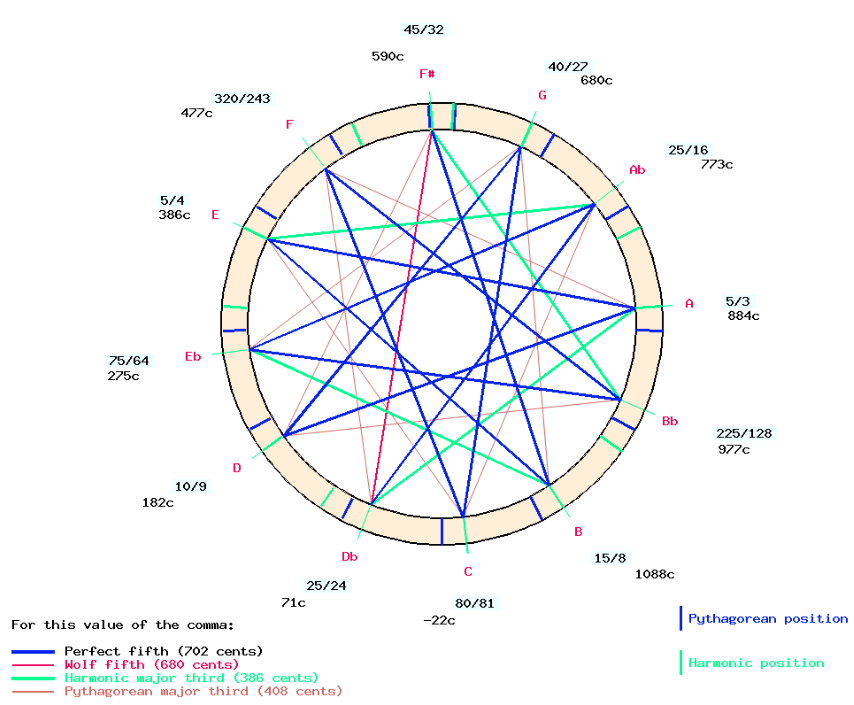
The note "E" has a frequency ratio of 5/4, which is labelled "MI-1" on the scale "2_cycles_of_fifths" (top of this page). Since "MI-1" belongs to a harmonic series, it cannot be taken as a the tonic of an "E major chord". The Pythagorean "MI" (ratio 81/64) should be used instead.
After its adjustment — raising all notes by 1 syntonic comma — the final "Emaj" scale is obtained:
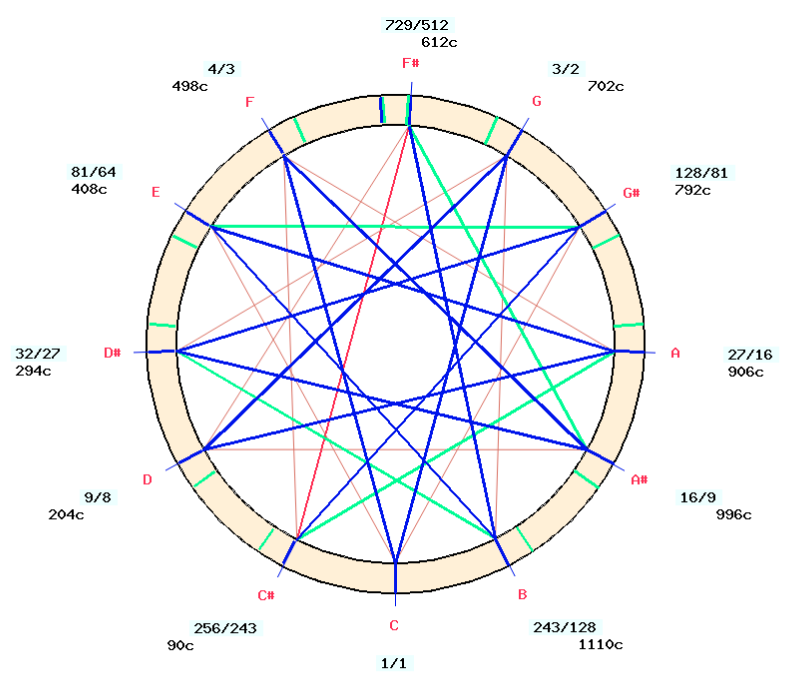
This alignment of exported major scales is done automatically by the Bol Processor when exporting a major chromatic scale.
References
Asselin, P.-Y. Musique et tempérament. Paris, 1985, republished in 2000: Jobert. Soon available in English.
Shringy, R.K.; Sharma, P.L. Sangita Ratnakara of Sarngadeva: text and translation, vol. 1, 5: 7-9. Banaras, 1978: Motilal Banarsidass. doi:10.2307/2054840. Source in the Web Archive.
